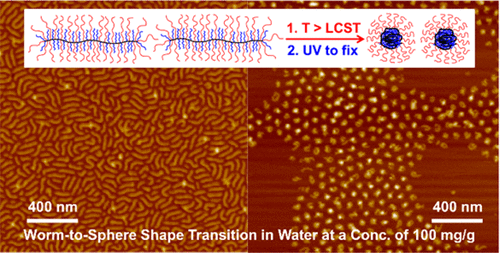当前位置:
X-MOL 学术
›
J. Phys. Chem. B
›
论文详情
Our official English website, www.x-mol.net, welcomes your feedback! (Note: you will need to create a separate account there.)
Worm-to-Sphere Shape Transition of Thermoresponsive Linear Molecular Bottlebrushes in Moderately Concentrated Aqueous Solution
The Journal of Physical Chemistry B ( IF 3.3 ) Pub Date : 2018-06-29 , DOI: 10.1021/acs.jpcb.8b04767 Daniel M. Henn 1 , Jessica A. Holmes 1 , Ethan W. Kent 1 , Bin Zhao 1
The Journal of Physical Chemistry B ( IF 3.3 ) Pub Date : 2018-06-29 , DOI: 10.1021/acs.jpcb.8b04767 Daniel M. Henn 1 , Jessica A. Holmes 1 , Ethan W. Kent 1 , Bin Zhao 1
Affiliation

|
Molecular bottlebrushes have been shown to exhibit intriguing worm-to-sphere shape transitions in response to external stimuli. However, such shape changing has been restricted to dilute solutions, typically <1.0 mg/g, or at interfaces. Here we report a method for achieving worm-to-sphere shape transitions of linear molecular bottlebrushes in moderately concentrated aqueous solutions by using binary heterografted molecular brushes composed of a poly(ethylene oxide) (PEO) and a thermoresponsive polymer as side chains. The PEO was designed to be significantly longer so that the thermoresponsive side chains were well shielded by PEO to avoid intermolecular association during the lower critical solution temperature transition. To facilitate the analysis by dynamic light scattering (DLS) and atomic force microscopy (AFM), a suitable amount of cross-linkable cinnamate groups was introduced into the thermoresponsive polymer, allowing fixing of the brush shape at higher temperatures by UV irradiation. To demonstrate the effect of relative chain lengths of the two side chain polymers, three brush polymers, BMB-5k, -2k, and -750, were synthesized by grafting an alkyne end-functionalized thermoresponsive, UV-cross-linkable polymer with a DP of 43 and a PEO with a DP of 114, 45, or 17, respectively, in a molar ratio of 1:1 onto an azide-bearing backbone polymer via a copper(I)-catalyzed click reaction. While BMB-2k and -750 underwent intermolecular aggregation in water at a concentration of 10 mg/g upon heating, DLS and AFM studies showed that BMB-5k collapsed intramolecularly and transformed from a wormlike to a spherical shape at concentrations of 10 and 25 mg/g. Even at a concentration of 100 mg/g, at least 95% of brush molecules underwent a worm-to-sphere transition from AFM analysis of the UV-cross-linked BMB-5k at a higher temperature. The method reported here may enable new opportunities for potential applications of shape changing molecular brushes.
中文翻译:

在中等浓度水溶液中热响应线性分子牙刷的蠕虫到球形的形状转变
分子牙刷已显示出响应外部刺激而引人入胜的蠕虫到球形的转变。然而,这种形状改变已被限制为通常<1.0mg / g的稀释溶液或界面处。在这里,我们报告了一种方法,该方法通过使用由聚环氧乙烷(PEO)和热响应性聚合物作为侧链的二元异质接枝分子刷,在中等浓度的水溶液中实现线性分子瓶的蠕虫到球形的转变。PEO被设计为明显更长,从而使热响应性侧链被PEO很好地屏蔽,从而在较低的临界溶液温度转变过程中避免了分子间缔合。为了通过动态光散射(DLS)和原子力显微镜(AFM)进行分析,将适量的可交联肉桂酸酯基团引入热响应性聚合物中,从而允许通过紫外线辐射在较高温度下固定刷子形状。为了证明两个侧链聚合物的相对链长的影响,通过将炔末端官能化的热响应性,UV交联性聚合物与DP接枝合成了三种刷状聚合物BMB-5k,-2k和-750。通过铜(I)催化的点击反应,将43摩尔的聚四氟乙烯和具有114、45或17的DP的PEO分别以1:1的摩尔比添加到带有叠氮化物的骨架聚合物上。虽然BMB-2k和-750在加热时以10 mg / g的浓度在水中进行分子间聚集,但DLS和AFM研究表明BMB-5k在分子内塌陷并在10和25 mg的浓度下从蠕虫状转变为球形。 /G。即使在100 mg / g的浓度下,在较高的温度下,至少有95%的刷子分子经历了从UV交联的BMB-5k的AFM分析到蠕虫到球形的转变。此处报道的方法可能为形状可变的分子刷的潜在应用提供新的机会。
更新日期:2018-06-30
中文翻译:

在中等浓度水溶液中热响应线性分子牙刷的蠕虫到球形的形状转变
分子牙刷已显示出响应外部刺激而引人入胜的蠕虫到球形的转变。然而,这种形状改变已被限制为通常<1.0mg / g的稀释溶液或界面处。在这里,我们报告了一种方法,该方法通过使用由聚环氧乙烷(PEO)和热响应性聚合物作为侧链的二元异质接枝分子刷,在中等浓度的水溶液中实现线性分子瓶的蠕虫到球形的转变。PEO被设计为明显更长,从而使热响应性侧链被PEO很好地屏蔽,从而在较低的临界溶液温度转变过程中避免了分子间缔合。为了通过动态光散射(DLS)和原子力显微镜(AFM)进行分析,将适量的可交联肉桂酸酯基团引入热响应性聚合物中,从而允许通过紫外线辐射在较高温度下固定刷子形状。为了证明两个侧链聚合物的相对链长的影响,通过将炔末端官能化的热响应性,UV交联性聚合物与DP接枝合成了三种刷状聚合物BMB-5k,-2k和-750。通过铜(I)催化的点击反应,将43摩尔的聚四氟乙烯和具有114、45或17的DP的PEO分别以1:1的摩尔比添加到带有叠氮化物的骨架聚合物上。虽然BMB-2k和-750在加热时以10 mg / g的浓度在水中进行分子间聚集,但DLS和AFM研究表明BMB-5k在分子内塌陷并在10和25 mg的浓度下从蠕虫状转变为球形。 /G。即使在100 mg / g的浓度下,在较高的温度下,至少有95%的刷子分子经历了从UV交联的BMB-5k的AFM分析到蠕虫到球形的转变。此处报道的方法可能为形状可变的分子刷的潜在应用提供新的机会。































 京公网安备 11010802027423号
京公网安备 11010802027423号